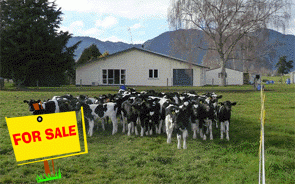
Sales of working farms slowed sharply in September with only 77 units changing hands, 25% less than the same month a year ago
The number of farms sold in September fell to a 19 month low. Only 77 units changed hands compared with 103 in the same month a year ago, and an average of 90 for a September over the previous four years.
In fact only two dairy units sold in September, one in Southland and one in Canterbury.
The median selling price per hectare for dairy units fell to a recent low of just $19,604 for the three months to September.
Overall, sales numbers were especially low for all types of farms, although grazing units held up best.
The real estate industry is noting that there is a serious shortage of farms listed for sale and this will keep the trading numbers low for some time yet.
“Unsettled weather and market conditions have put a dampener on the early spring rural real estate market,” says REINZ Rural Market Spokesman Brian Peacocke. “Cold, wet conditions have impacted on feed supplies and production resulting in increased ‘on farm’ stress.”
“We are seeing strong demand for quality dairy and larger sheep and beef farms, but the shortage of listings is a serious constraint on buyers. Whilst we are expecting more properties to come to market during October and November, the anticipated increase is unlikely to be sufficient to meet the increasing demand.”
September sales included:
4 arable farms, at an average per hectare of $25,629 (July was $24,025)
2 dairy farms, at an average per hectare of $19,604 ($24,492)
16 finishing units, at an average per hectare of $22,468 ($20,941)
40 grazing properties, at an average per hectare of $11,444 ($11,297)
8 horticultural, at an average per hectare of $141,968 ($130,000)
7 farms of other types
You can find more detail on our Resources page here »
Farm sales
Select chart tabs
1 Comments
How to establish the value of neighbours farm? It’s a tidy dry stock unit, we are dairy. Purely productive, or do we factor in capital gain and associated price (credit) above productive value?
We are currently a family scale farm, but according to Prof Hamish Gow, land ownership structure is going to change, with large urban based corporates owning land and operators leasing it. Seems like a lot of ticket clippers involved in land ownership and operation for what it currently produces and earns. Prof Gow believes we need to better target our marketing and seperate processing and marketing structure. Will this increase product value allowing non farming owners as well as operators to make gainful profit? Is this another way of saying the family farm is history, don’t bother competing in the land purchase market, succession is going the way of the dodo, leave it to the corporates? Interesting interview with Prof Gow, on future of agriculture in NZ. Worked for World Bank (free market ideology ?) introduced some innovative and possibly noble ideas regarding improving agriculture in the third world, now professor at Massey University.
5 mins in gets interesting.

We welcome your comments below. If you are not already registered, please register to comment
Remember we welcome robust, respectful and insightful debate. We don't welcome abusive or defamatory comments and will de-register those repeatedly making such comments. Our current comment policy is here.